Theoretical mathematical physics is an evolving endeavor of natural philosophy
1)Newtonian laws of motion and theory of gravitation
2)Electromagnetism
3)General relativity
5)Particle physics and the Standard Model of matter
In times to come, one can expect
6)Algebraic geometry of Calabi-Yau manifolds to play an increasing role
7)The notion of spacetime and spatial dimensions will separate from time
8)Vibrating strings that encompass energy to behave as both particles and waves
The realm of mathematics is immense, and here is a map of where things are at today, but every day new realms and linkages between existing realms are uncovered. 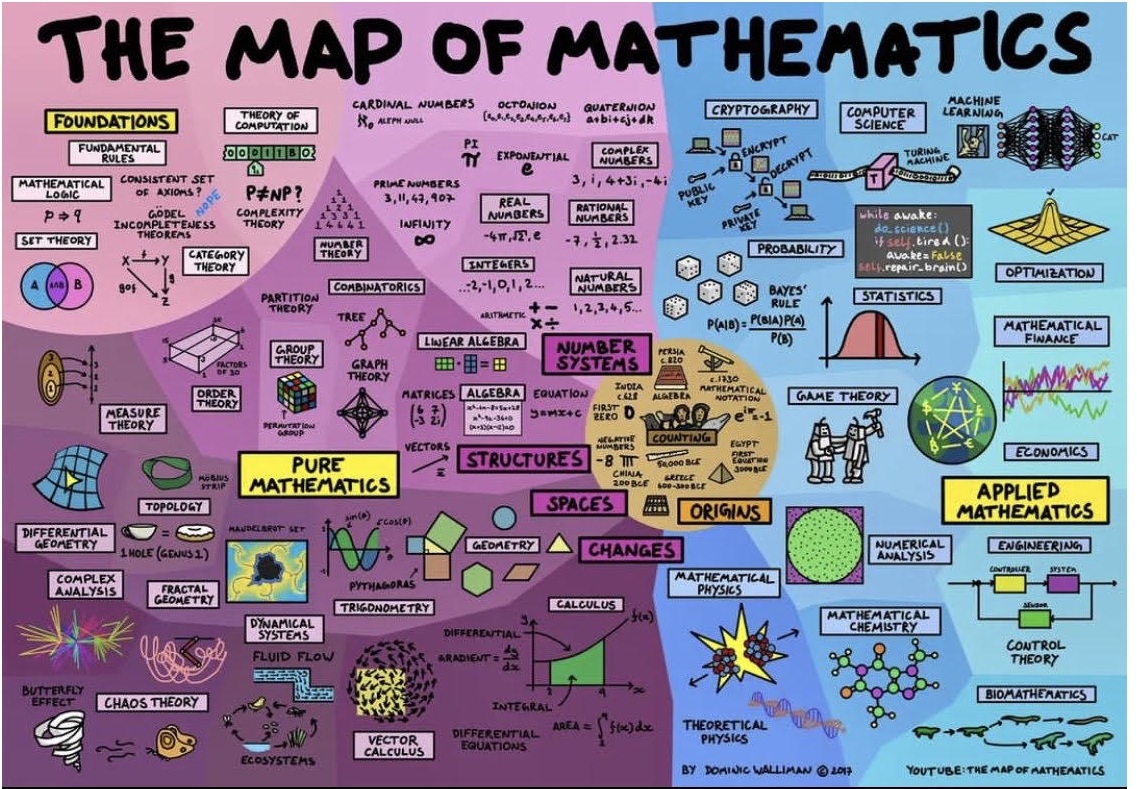
Theoretical mathematical physics saw its foundations laid by Isaac Newton with his publication in 1687 of Philosophiæ Naturalis Principia Mathematica which developed mechanics and gravitation based on the mathematics of calculus. The underlying geometry was three dimensions for space, which was infinite in all directions and one dimension for time; the difference in space and time was that in space one could move forward and backward, up and down, right and left, while time only had one direction, forward, and only one moment, the present, which provided a demarcation of the past from the future. Time was different from the spatial dimensions: it determined that if there was a cause at a given point in time and space, then at a later point in time and in space there would be an effect.
Since then, it has become clear that the universe is based on the arithmetic, algebra and geometry of complex numbers. Complex numbers have a real and an imaginary part, but are only one single complex number. All of mathematics needs to be recast to encompass complex numbers as it true basis. It may well be that the octonions (or even modular forms), not the reals or complexes or quaternions, are the natural set of numbers.
In the 1910-1930 time frame telescopes became sufficiently powerful that distant clumps of stars could be resolved into independent galaxies each with tens of millions of stars, typically in spirals revolving around a common center of gravity. If one assumed that each of the stars had a mass comparable to the Sun, and gravitation linked all the stars to one another, then rudimentary calculations showed that the galaxy would spin apart in a very short (in galactic terms) time scale, unless there was additional matter that could not be seen that provided additional gravitational force to bind all the stars in a galaxy into a common revolving spiral: this missing matter was called dark matter. In addition, all the galaxies were observed to be moving away from one another, which implied that in the distant past they had all been in a common volume; the energy driving the galaxies apart was expanding space itself, and was called dark energy. Current estimates are that matter comprises roughly 5% of all the mass/energy in the universe, dark matter comprises 27%, and dark energy 68%. Where is this dark matter and dark energy? One possibility is that it resides in dimensions other than the three spatial dimensions of matter, so if matter makes up 1/20 of the mass/energy of the universe in three dimensions, the universe has 60(=3/(1/20)) dimensions; a different sizing is that if matter and dark matter together make up 32% of the mass/energy of the universe in three dimensions, then the universe consists of nine dimensions (3/0.32). If matter is in three dimensions and dark matter in an adjacent subspace of three dimensions, then 32% of the mass/energy of the universe is in six dimensions, so the universe consists of 18(=6/0.32) dimensions. If matter is in four dimensions for space-time, and dark matter is in four dimensions for space-time, then the universe consists of 24(=8/0.32) dimensions. In fact, the answer is that the universe resides in 26 dimensions, 24 spatial dimensions and 2 temporal dimensions (time is different!).
The 24 real spatial dimensions lead to the Leech lattice, where each sphere in 24 dimensions with radius one just kisses or touches 196,560 other spheres. The platonic solids (hexahedron or cube with six sides, octahedron or pyramid with tetrahedron sides, octahedron, icosahedron and dodecahedron) are all hints of other types of symmetry the universe is built on.
The five platonic solids (tetrahedron, cube, octahedron, icosahedron, dodecahedron) all display rotational symmetries from different finite simple groups. After 150 years mathematics has been able to classify all finite simple groups into 20 classes, a periodic table of symmetries, but wait: there are 26 sporadic classes that do NOT fit into the 20 classes, and yes, the study of symmetry has resulted in finding asymmetry! The 26 sporadic groups each may be linked to a separate dimension of our 26 real dimensional universe, and these sporadic groups themselves have many additional dimensions, with the largest sporadic group, the Monster group (yes, that is indeed the name!) has 47x59x71=196,883 dimensions. These extra dimensions are accessed from the 26 real dimensional space by raising or lowering energy; think of walking on a plane, and as you raise your energy you rise up and look down on the plane but are INVISIBLE to those on the plane. This may explain what was found in Book Three of the Yoga Sutras of Patanjali, especially sutras 3.25-3.30, where it is possible to be invisible, to walk through walls, and other traits of the enlightened.
Metamathematics rules the universe, and gives rise to metaphysics. The 20 finite simple symmetry groups of the 24 spatial dimensions give rise to resonances: the five platonic solids all reflect these symmetries and resonant throughout the universe with like solids. The 26 sporadic finite simple groups each link with one of the 26 real dimensions of the universe, and provide cloaking: as you raise your energy, you effectively rise up in dimensions and look down on the existing space, but are invisible, and can in fact walk through walls!
To summarize, there are three ways to have extra dimensions beyond the three spatial dimensions we see around us. First, we can rotate a dimension perpendicular to itself, so it is still present: we do this by multiplying the dimension by the square root of minus one, so when viewed in the complex plane, a real vector of unit length is rotated to an imaginary vector of unit length. An example of this rotation is time: the reality is that when the equations of electromagnetism are viewed as taking the gradient or exterior derivative of the gauge to get the potential, taking the gradient or exterior derivative of the potential to get fields, taking the gradient or exterior derivative of fields to get current densities, and taking the gradient or exterior derivative of current densities to get sources, the natural units are (x,y,z,ict), i.e. time is converted first into a length by multiplication by the speed of light, and then rotated ninety degrees. For our three spatial dimensions we can go back and forth, up and down, right and left, but for time we only have the present, not the past or the future. This is also used in compactified dimensions, so twenty four real dimensions are in fact paired as twelve real and twelve imaginary. The second approach is compactified dimensions, where if you walk along a particular dimension in our real space, there is rolled around that dimension a plane of one real and one complex dimension, but twice. The third approach is to imagine that you are walking in a two dimensional space (done for simplicity of exposition) but as you raise your energy you move up into higher dimensions that allow you to look down on the two dimensional space you were in but now you are invisible to those in the original two dimensional space.
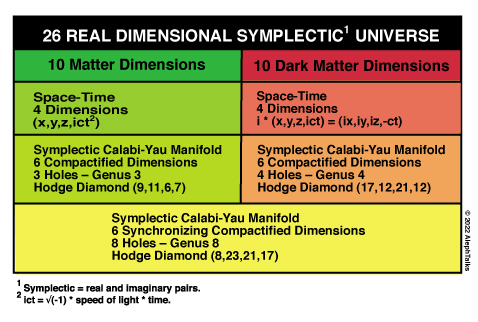

A wide variety of experiments with electricity and magnetism led to the codification of a general theory of electromagnetism in 1861-1862 by James Clerk Maxwell. As one example, Michael Faraday carried out a variety of experiments on electricity and magnetism starting in 1812 and in 1831 discovered that a current is one coil of wire induces a current in a separate coil of wire. He showed that a bar magnet has a magnetic field by placing iron filings on a blank piece of paper with the bar magnet under the paper, which experiment is widely duplicated since then around the world. What is amazing is that Faraday was WRONG: the actual magnetic field of the bar magnetic starts at the north pole, circles around to the middle of the bar, then comes out of the middle of the bar and goes to the south pole! The iron filings Faraday used act as magnets and distort the true magnetic field of the bar magnet; the linked video shows the bar magnetic field via the phosphors of a screen with no magnetic materials to make this clear.
Maxwell employed an extension of calculus to encompass vector concepts. Maxwell suggested that electromagnetic waves would propagate at the speed of light, and indeed light was a form of electromagnetism.
In 1845 the polymath Hermann Grassmann published Neue Theorie der Elektrodynamik where he extended the notion of calculus to an exterior derivative, and developed all of Maxwell's equations decades ahead of Maxwell, by taking successive gradients of scalar functions, vector functions, bivector functions, trivector functions, et al.
In 1974 Bart Stuck published a popular exposition of Grassmann's idea On Some Mathematical Aspects of Classical Electrodynamics, and in particular developed a Grothendieck inspired commutative diagram for electromagnetism: gauge -> potential -> fields -> currents -> sources. The key observation here was that the free space equations of electromagnetism have nothing to do with physics per se, they arise from successive exterior differentations (successive gradients) of functions of space-time.
Only when the etheric fluid mechanics of space changing its density from point to point are included can electromagnetism be comprehended.
Arnold Sommerfeld in his magisterial book Partial Differential Equations in Physics, Academic Press, 1964 observed that the equations of electromagnetism and for fluid mechanics were quite similar, but the equations for fluid mechanics included terms dealing with the fluid density, leading to richer phenomena than if this were ignored. In fact, if one realizes that the fluid for electromagnetism is the ether, the discrete quantum foam of space itself that particles hop from compartment to compartment, then one can carry out a perturbation analysis of Maxwell's equations including the density of the ether. If one does this, the zeroth order set of equations are those of Maxwell, while when first and second order terms are included, one can see the strong force (where positively charged protons at very short distances attract one another in the nucleus of atoms at very short distances), the weak force (where neutrons decay to protons, electrons and neutrinos in a nucleus to create isotopes), and finally where gravity itself is seen as being reflected in the density of space itself, ala Einstein and his general theory of relativity. This is the path that was not taken by mainstream physics, but was taken by certain individuals, notably Nikola Tesla starting in the 1890s.
The theory of general relativity can be extended to a complex dimensional realm, and this leads to a unification of physics. The equations are in a 26 real dimensional space, or in a 13 complex dimensional space.
Quantum field theory encompasses the quantization of space itself into compartments that subquarks hop between, all while obeying an exclusion principle of no more than two subquarks per space compartment.
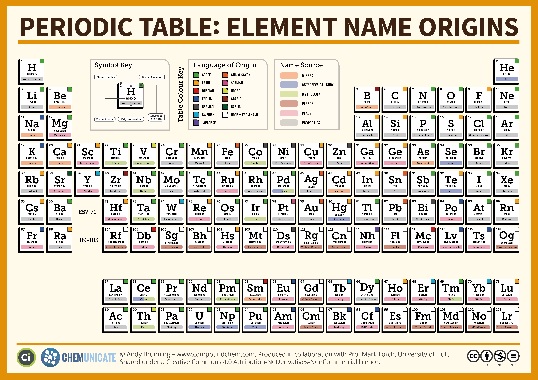
Chemistry developed its periodic table of elements over time, and physics showed this was due to the underlying structure of electrons surrounding nuclei of protons and neutrons.
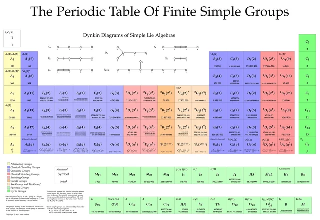
Mathematics developed its own periodic table of finite simple groups that form the basic (or simple) elements of symmetry. This took place from 1832 with Evariste Galois, Killing, Lie and Cartan in the 1870s to 1890s, and Chevalley, Dynkin, Thompson, Tits and Conway in the 1960s to 1980s, until final closure in 2010, and involved hundreds of mathematicians. The 18 families of symmetries are the basis for all symmetry, but what was surprising was that there were 26 families of sporadic finite simple groups that do not fall into any of these categories.
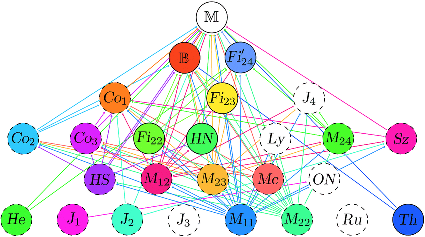
Killing and Lie originally discovered five of these sporadic groups, with an underlying linkage to octonions. One of these five, E8, has 248 dimensions, and all five of these sporadic groups are tied to the octionions in different ways. Note that the universe has eight subspaces of three spatial dimensions each.
The 18 classes of finite simple groups may be linked to the 18 compactified dimensions of the universe. The 26 sporadic finite simple groups appear to be linked to the 26 real dimensions of the universe, in a manner yet to be determined. One possible explanation is that each dimension is linked to one of the 26 sporadic groups, and each of these groups has its own underlying geometry with additional dimensions that link to the single spatial dimension. For example, the monster group has 47x59x71=196,883 dimensions that apparently can be reached by raising or lowering the intrinsic vibrational energy of a given dimension.
Emmy Noether was one of the leading mathematicians of the 20th century. Noether's theorem or Noether's first theorem states that every differentiable symmetry of the action of a physical system with conservative forces has a corresponding conservation law. The theorem was proven by mathematician Emmy Noether in 1915 and published in 1918. The action of a physical system is the integral over time of a Lagrangian function, from which the system's behavior can be determined by the principle of least action. This theorem only applies to continuous and smooth symmetries over physical space.
The 18 families of finite simple groups lead to one set of conservation laws (e.g., conservation of linear momentum and angular momentum arise from rotational symmetries, while conservation of energy arises from translations in time). The 26 sporadic finite simple groups lead to a different set of conservation laws, far richer than the original conservation laws of energy and momentum.
Wilfred Grassmann was a German polymath who created the mathematical underpinnings of vector spaces:
The definition of a linear space (vector space) became widely known around 1920, when Hermann Weyl and others published formal definitions. In fact, such a definition had been given thirty years previously by Peano, who was thoroughly acquainted with Grassmann's mathematical work. Grassmann did not put down a formal definition – the language was not available – but there is no doubt that he had the concept.
Beginning with a collection of 'units' e1, e2, e3, ..., he effectively defines the free linear space that they generate; that is to say, he considers formal linear combinations a1e1 + a2e2 + a3e3 + ... where the aj are real numbers, defines addition and multiplication by real numbers [in what is now the usual way] and formally proves the linear space properties for these operations. ... He then develops the theory of linear independence in a way that is astonishingly similar to the presentation one finds in modern linear algebra texts. He defines the notions of subspace, linear independence, span, dimension, join and meet of subspaces, and projections of elements onto subspaces...few have come closer than Hermann Grassmann to creating, single-handedly, a new subject.
The 26 real dimensional description of the universe draws heavily on Grassmann's notions.
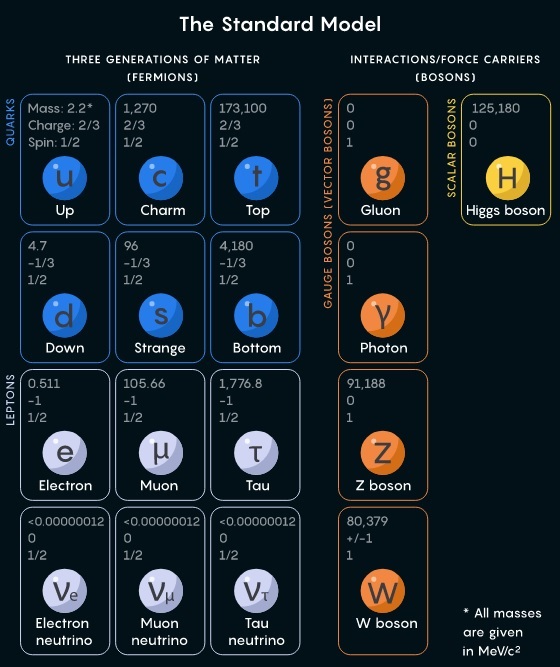
The standard model is arguably one of the most successful models in physics; having said that, the standard model is incomplete in that it cannot account for dark matter (which Ron Cowen did through his observations, which led to a more comprehensive standard model for matter and dark matter). One of the observations made by Ron Cowen was that the ten dimensional subspace associated with matter has six compactified dimensions with three holes; Witten and Strominger observed that the electron would have three resonances if the associated matter brane had three holes, and this is indeed what Ron Cowen observed, so the electron is fundamental and the other two resonances (the muon and the tau particles) are a byproduct of the underlying geometry. Similarly, the standard model shows there is an electron neutrino with two resonances (muon neutrino and tau neutrino).
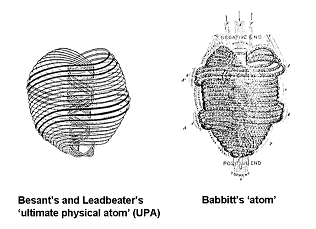
In the 1880s Babbitt entered into deep meditation and saw a subquark (see sketch he made) showing a bundle of energy contained in ten closed strings. In 1894 Annie Besant and Charles Leadbeater duplicated those observations with each checking the other.
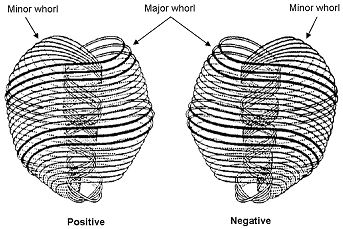
The geometry of the universe has evolved over time. Newton viewed the geometry as involving three spatial dimensions and one time dimension. Maxwell noticed a linkage between space and time, Lorentz pursued this, and Einstein and Minkowski codified this as space-time of four dimensions with time on an equal footing as the three spatial dimensions.
In the 1920s optical telescopes showed that stars were clustered into spiral galaxies bound by gravitational attraction; when estimates were made, however, it was clear that much of the matter of a galaxy was unseen or dark in order for the galaxy not to fly apart. Similarly, all the galaxies were observed to be moving away from one another, driven by an unseen or dark energy. Where is this dark matter and dark energy stored? One hypothesis is that it is in extra dimensions, e.g., if (1/8) of the matter/energy in the universe known today is in 3 spatial dimensions, then our universe has 3/(1/8)=24 spatial dimensions.
Richard Feynman in 1962 gave a series of lectures at CalTech, Feynman Lectures on Gravitation, CRC Press, 2002. He pursued what would be required to have a self consistent theory of quantum gravity based on a particle called a graviton which could possess properties such as spin. Feynman showed that the simplest possible such theory for quantum gravity would require a spin = 2 graviton, i.e., theories for spin = 0 and for spin = 1 would not be self consistent. This led Claud Lovelace in 1970 to investigate bosons generated from vibrating strings in a space with spin = 2 gravitons; Lovelace discovered that if he had four dimensions for space-time, a variety of inconsistencies arose such as faster than light tachyon particles, but when he increased the number of dimensions from four to twenty six everything was self consistent with a 26 dimensional bosonic universe!
This led to the current geometry of the universe, 26 real dimensions, 24 spatial dimensions and 2 time dimensions, in symplectic pairs. The matter subspace consists of three spatial dimensions and one time dimension, with six compactified real spatial dimensions, paired as real and imaginary parts of a three complex dimensional space. The dark matter subspace consists of three spatial dimensions and one time dimension (the imaginary part of the same dimensions for matter, its symplectic pair), and six compactified real spatial dimensions, aired as real and imaginary parts of a three complex dimensional subspace. The final six compactified dimensions are real and imaginary parts of a three complex dimensional subspace linking the two other compactified subspaces. It is important to note that the compactified six real dimensional subspace for matter has three holes, the compactified six real dimensional subspace for dark matter has four holes, and the final compactified six real dimensional subspace has eight holes, suggesting that the three holes for the matter compactified subspace connect to three of the eight holes in the linking compactified subspace, that the four holes for dark matter compactified subspace connect to four of the eight holes in the linking compactified subspace, and the final hole of the eight connects with itself in the linking subspace.



Ronald Cowen made a major observation through deep meditation in the 1995-2019 time frame: space is quantized into 24 spatial dimension compartments with the walls of these compartments covered with information blocks that contain both algorithms and data. The blocks are constantly scanning their surroundings, and if a change is perceived, the algorithms cause a change in all spatial compartments. This shows that the pilot wave theory of Louis de Broglie and David Bohm is the correct interpretation of quantum mechanics, which is shown as controlling physics, chemistry and biology. Since information is a type of mathematics, metamathematics is the fundamental structure of the universe, and metaphysics is derived from metamathematics.
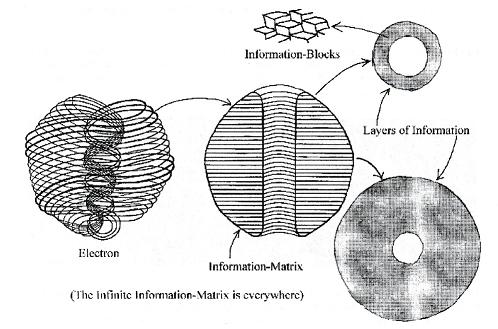
Ronald Cowen observed the electron is in fact a nodule of resonant energy enclosed in ten vibrating strings. Quantum field theory observes that all matter is in fact resonant energy. The electron is a torus, and is covered with information blocks that are constantly scanning its surroundings: this explains the electron double slit experiment where the electron behaves as a particle with one slit and as a wave with two slits.
Ron observed that matter had ten strings vibrating that created a resonant energy state which was a particle, while dark matter had five strings vibrating. A key difference is that matter includes an electron while there is no comparable electron for dark matter.

Ron Cowen carried out many observations through deep meditation and then made drawings. Here is a drawing of a proton, which he saw composed of three quarks (in accordance with the standard model of theoretical physics) but the quarks are vibrating at incredible frequencies, leading to a deformation in the two hemispheres that make up a proton.
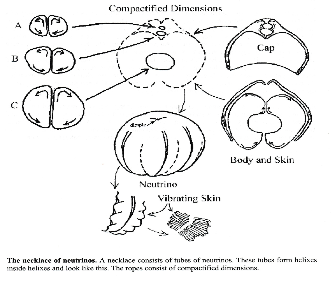
Ron Cowen observed a neutrino consisting of a torus shape.

Ron Cowen observed a boson (e.g., a photon) in deep meditation consisting of a torus shape.
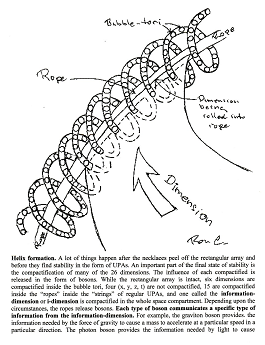
Ron Cowen carried out detailed observations of the strings that vibrate throughout the universe and create various particles as resonant clumps of energy. Here is one sketch that shows a string is in fact wrapped in a string, and there are evidently seven levels of each string being wrapped by another string.

Ronald Cowen observed that matter and dark matter are each made up of basic entities called subquarks. For matter, three subquarks make one quark, and three quarks make a proton or an electron. For dark matter subquarks which have no electric charge but again has the physical scale of matter subquarks, the dark matter subquarks combine together as a type of fern (one example is shown here) and when a critical number of subquarks are combined then a level of sentience is achieved, which Ron Cowen called a mind form. In his book he drew pictures of mind forms making up the seven principal chakras in a human body.
The underlying equations that describe the universe must encompass not only the concepts from general relativity but also from quantum mechanics and quantum field theory; the quantization of space led to Ron Cowen observing that no more than two subquarks could occupy a space compartment at the same time, a Pauli exclusion principle. The equations would also encompass the vibrations of ten closed strings for matter and the vibrations of five closed strings for dark matter. The underlying brane would have to include the holes in the compactified dimensions as well. A lot of work still needs to be done to address all these issues: they are not insurmountable, just trying to show still has to be done.
The hidden dimensions were viewed as compactified by the German mathematician Klein when Einstein was looking at the extension of his theory of relativity to a fifth dimension that allowed the equations to encompass electromagnetism. A different approach is to think of Abbott's 1884 Two Dimensional Flatland: A Romance of Many Dimensions. If there is a three dimensional space, it has many two dimensional subspaces, and each time energy is raised or lowered this results in raising or lowering the two dimensional subspace which is then invisible to those staying in the original two dimensional subspace. The hidden dimensions that arise from the sporadic finite simple groups allow transitions from one dimension to another, effectively cloaking or hiding, but the hidden entity can still see what is happening in the other dimension(s).
Modern western physics identifies four forces in the universe: electromagnetism, the strong force that attracts positively charged protons and neutral charged neutrons in the nucleus of atoms, the weak force that splits a neutron into a proton and an electron and a neutrino in the nucleus of an atom, and gravity. Gravity is by far the weakest of these four forces. If we adopt an etheric electromagnetism view, then the three forces of electromagnetism, strong force and weak force, are all different aspects of one etheric electromagnetic force, while gravity is due to the variations in the density of the ether, and as such is far weaker.
Protons and neutrons are made up of quarks; an up quark has a charge of +2/3 of the charge on a proton, a down quark has -1/3 the charge of an electron, and a proton is made up of two up quarks and one down quark, while a neutron is made up of one up quark and two down quarks. One of the reasons for the number three may be that there are three holes in the matter subspace of six compactified dimensions, and quarks are displaying a resonance.
In 1990 Ron Cowen entered into deep meditation and duplicated the observations of Babbitt and Leadbeater and Besant. He observed, as did Leadbeater and Besant, that quarks were made up of subquarks that were ten closed vibrating strings that captured a resonant energy cloud.; He further observed that dark matter was made up of subquarks with five closed vibrating strings that captured a resonant energy cloud.
Matter subquarks have fractional charges of +5/9 of a positive charge on an protron and -4/9 the negative charge on an electron, so an up quark has charge of +2/3 of a proton made up of two subquarks of charge +5/9 and one subquark of charge -4/9, and a down quark has charge of -1/3 of the charge on an electron made up of two subquarks of charge -4/9 and one subquark of charge +5/9.
Ronald Cowen carried out observations at the Big Bounce start of this universe: he did so by drawing on the memory of mind forms going back to that instant. This is summarized here, but the main point is that the Big Bounce is indeed correct, while the Cosmic Background Radiation observed by modern science appears to be a collision between our universe and another universe in the multiverse of universes that occurred about 13.8B years ago, so our universe is probably trillions of years old.
Additional videos are available on YouTube.com/bartstuck and include AlephTalks class videos as well as select other videos on special topics in theoretical mathematical physics.